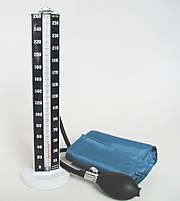New blood pressure guideline creates a new level of disease affecting people previously deemed healthy
 From NEJM:
From NEJM:The guideline defines normal blood pressure as below 120/80 mm Hg and elevated blood pressure as 120 to 129. What is now called stage 1 hypertension was previously labeled “prehypertension” — a term meant to alert patients and to prompt physicians to provide lifestyle education
By reclassifying people formerly considered to have prehypertension as having hypertension, the guideline creates a new level of disease affecting people previously deemed healthy. According to this definition, about 46% of U.S. adults have hypertension, as compared with about 32% under the previous definition.
The guideline recommends daily sodium intake of less than 1500 mg — a goal that’s difficult for many people to achieve and that was derived from short-term studies.
The primary change in recommendations regarding pharmacologic therapy is the elimination of beta-blockers from first-line therapy for patients with primary hypertension.
Read more here:
Redefining Hypertension — Assessing the New Blood-Pressure Guidelines | NEJM http://bit.ly/2nVBJgJ

Main complications of persistent high blood pressure. Image source: Wikipedia, public domain.
Image sources: Top left, Record breaking snowfall March 2008 at Aubrey, Texas, Wikipedia, public domain; Top Right, Mercury manometer, Wikipedia, GNU Free Documentation License.